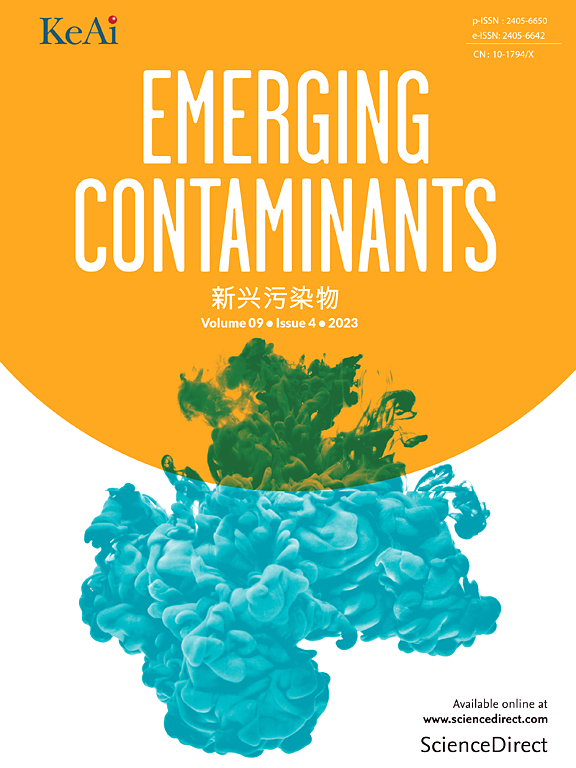Atomic Force Microscopy (AFM) nanomechanical characterization of micro- and nanoplastics to support environmental investigations in groundwater
IF 6.9
2区 环境科学与生态学
Q1 ENVIRONMENTAL SCIENCES
引用次数: 0
Abstract
Micro and nanoplastic (MNP) pollution is a severe environmental issue, posing potential risks to environmental and human health due to the intrinsic toxicity of plastic particles and their capacity to adsorb other pollutants. The diffusion of plastic debris affects all the environmental domains, including groundwater which was erroneously believed to be protected by the porous structure of the soil. Advanced spectroscopic techniques can detect the polymer type and quantify the number of MNP particles but are affected by large uncertainties in case of particles smaller than 10 μm in size and MNP heteroaggregates. To advance in the morphological and mechanical characterization of MNPs, a new protocol based on multifrequency Atomic Force Microscopy (AFM) is proposed with the support of the custom open software “MultiFreq AFMSuite”. Reconstituted MNP samples in pristine and aged conditions are used to fine-tune the methodology. Multifrequency AFM allows the detection of MNPs up to the nanometric scale based on elastic modulus assessments. The proposed technique also provides an in-depth analysis of the MNP surface roughness and the morphological characterization of particle aggregates. MNP particles from groundwater samples result in aggregates with a roughness of one to two orders of magnitude higher than the plastic particles aged in the laboratory, suggesting a higher adsorption capacity towards pollutants or other natural compounds. The application of the proposed method can facilitate the characterization of micro-and nanoplastics in groundwater, a resource characterized by large uncertainties in hydrodynamics and pollutant transport.

原子力显微镜(AFM)纳米力学表征的微和纳米塑料,以支持地下水的环境调查
微纳米塑料污染是一个严重的环境问题,由于塑料颗粒的内在毒性及其吸附其他污染物的能力,对环境和人类健康构成潜在风险。塑料碎片的扩散影响到所有的环境领域,包括地下水,地下水被错误地认为是由土壤的多孔结构保护的。先进的光谱技术可以检测聚合物类型并量化MNP颗粒的数量,但在粒径小于10 μm的颗粒和MNP异质聚集体的情况下,受较大的不确定性影响。为了进一步研究MNPs的形态和力学特性,在自定义开放软件“MultiFreq AFMSuite”的支持下,提出了一种基于多频原子力显微镜(AFM)的新协议。在原始和老化条件下重建的MNP样本用于微调方法。多频AFM允许基于弹性模量评估的MNPs检测到纳米尺度。该技术还提供了MNP表面粗糙度和颗粒聚集体形态表征的深入分析。地下水样品中的MNP颗粒形成的聚集体的粗糙度比实验室中老化的塑料颗粒高一到两个数量级,这表明它们对污染物或其他天然化合物的吸附能力更高。该方法的应用有助于表征地下水中微塑料和纳米塑料的特征,而地下水是一种具有很大水动力学和污染物运移不确定性的资源。
本文章由计算机程序翻译,如有差异,请以英文原文为准。
求助全文
约1分钟内获得全文
求助全文
来源期刊

Emerging Contaminants
Medicine-Public Health, Environmental and Occupational Health
CiteScore
10.00
自引率
6.70%
发文量
35
审稿时长
44 days
期刊介绍:
Emerging Contaminants is an outlet for world-leading research addressing problems associated with environmental contamination caused by emerging contaminants and their solutions. Emerging contaminants are defined as chemicals that are not currently (or have been only recently) regulated and about which there exist concerns regarding their impact on human or ecological health. Examples of emerging contaminants include disinfection by-products, pharmaceutical and personal care products, persistent organic chemicals, and mercury etc. as well as their degradation products. We encourage papers addressing science that facilitates greater understanding of the nature, extent, and impacts of the presence of emerging contaminants in the environment; technology that exploits original principles to reduce and control their environmental presence; as well as the development, implementation and efficacy of national and international policies to protect human health and the environment from emerging contaminants.
 求助内容:
求助内容: 应助结果提醒方式:
应助结果提醒方式:


